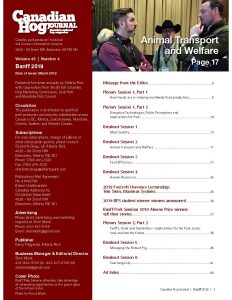Articles in the Banff 2019 Canadian Hog Journal Include:
How Trends are Re-Shaping Worldwide Food Production
- Eating is more meals-to-go and prepared ingredients. As population grows, Meat consumption will as well, but a lot of the emering population will be Hindu or Muslim which restrict the consumption of beef or pork. Chicken and fish consumption will increase. Plant-based “meats” are also becoming more popular.
Disruptive Technologies, Public Perceptions and Implications for Pork
- New technology can be used to make cellular meat, insect meat products and refined plant based meat products which can impact the traditional livestock markets. Health and animal welfare have led to consumers reducing pork intake. Genetic technologies are accepted in some areas more than others, so it is important to look at the consumer when contemplating the use of new technology.
Meat Quality: Confidence in Quality, Chewing the Fat: Pork is More than the Sum of its Protein
- Meat quality can be impacted by almost any point in production. Traditionally it was based on palatability. Current marketing drivers include farming methods, animal nutrition, genetics, trust in the meat delivery sector and nutrition in health.
- The pork industry has selected for leaner meats to reduce fat and fears of cardiovascular disease. By reducing fat consumption, carbohydrate intake increases which also has negative health effects. Now the trends are higher fat and less carbohydrates so high quality sources of fat will be in demand.
Animal Transport and Welfare: Canada’s Success in Self-Policed Industry Standards, International Lessons in Productivity
- The Canadian Livestock Transport Certification Program was developed to ensure animal welfare was preserved throughout all aspects of production.
- Denmark is leading in efficiency and breeding of swine. They have a national labelling system ‘The Heart Pig’ that assigns heart symbols based on the environment the animal was raised in including straw availability, tail docking, space requirements, access to outdoors and more.
Feed Efficiency: It’s all in the Genes, Getting with the Program
- New technologies allow more and more progress to be made in the pork industry. Precise examination of herd genetics can be completed and traits can be selected for to increase carcass quality and feed efficiency.
- A feed program for finisher hogs is important for their success at market. Determining energy values is very important. Fiber can also have a negative effect on carcass weight.
Human Resources: How Strong is Your Consulting Foundation?, Temporary Foreign Workers
- A successful integration of consultants into your production involves clarity on problems. Avoid free consulting and focus on consultants that benefit the client as a whole. Consultants that speak ill of competitors should also be avoided.
- Temporary foreign workers are often employed due to labour shortages. They are a vital option for Canada’s agricultural field.
BPS 2019 Aherne Prize Winners Tell the Story Behind Their Inventions:
- The piglet creep protection device deigned for loose housing and the tattoo master that automates tattooing are discussed.
Tariffs, Trade and Trepidation – Implications for the Pork Sector Now and into the Future
- Soybean and corn production along with foreign market imports and exports are discussed in regard to the pork sector.
Managing the Robust Pig: Batch Farrowing Basics, What to Expect from a Conversion to Batch Farrowing, How Nutrition Impacts Survivability
- Batch farrowing may be used to minimize group age ranges, use space better, easier disease eradication, reduced delivery and transportation costs, concentration of work and better opportunities for capturing herd data, It can also amplify management mistakes. 4, 5, and 6 week batching are discussed.
- For existing herds, hormones are needed to synchronize the sows into a breeding group. If boars are used naturally, a problem is created as four times as many boars are needed for a four-week batch and they are only needed for one week.
- Nutrition is important in survivability to help maintain the sows productivity. Nutrition can be used to increase later-term sows survivability and decrease stillborn rates and behavioural problems.
Sow Longevity: Gilt Management for Improved Sow Lifetime Productivity, Modeling the Economics of Sow Longevity, The Causes and Consequences of Sow Mortality
- Gilt management programs can identify gilts with the greatest potential lifetime productivity. Two key factors are gilt selection and litter of origin. Birth weight is a very important factor to consider, along with identifying early-maturing gilts and keeping sows in shape.
- A cost-benefit analysis was done to see the economics of investing in gilt development to improve sow longevity.
- Mortality rates of sows now average around 10%. Some factors are summer heatwaves, an increase in sow prolapses with risk factors being total number of piglets born, assisted farrowing, use of a toxin binder and Porcine Epidemic Diarrhea health status. Lameness was another common cause of death, mainly in younger breeding females. This is worrisome as a reduced return on investment is noted.